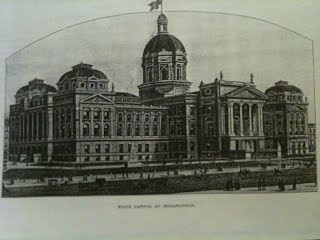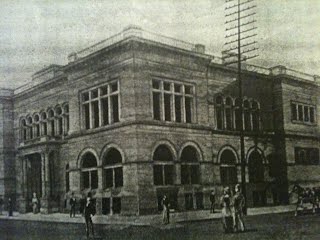Home |
Archives
|
Biographies | Biographies-offsite |
Cemeteries |
Cities/Towns |
Communities |
County
Courthouse | Courts |
Governors |
History
Hospitals | Libraries | Maps | Museums | Neighborhoods | Parks | Township Histories | Vital Records | Year Books
County Coordinator - Denise Wells
Hospitals | Libraries | Maps | Museums | Neighborhoods | Parks | Township Histories | Vital Records | Year Books
County Coordinator - Denise Wells


 Indiana
is bounded on the north by
Michigan, east by Ohio, south by
the Ohio river, and on the west
by Illinois. She has a total
area of 36,119 square miles, or
23,116,160 acres. To the east
and northeast of the city of
Indianapolis, there is an
inexhaustible supply of volitic
limestone, the most important
mineral deposit in the State.
In Washington County alone there
are 200 square miles of this
formation, much of which has an
average thickness of forty feet,
and many other counties have
equally as good deposits. This
stone, which is unexcelled for
building purposes, and of which
there is an unlimited supply,
exists chiefly in Putnam,
Monroe, Owen, Lawrence and
Washington counties. A large
coal producing area, covering a
tract of 7,000 miles, extends
through Fountain, Vermillion,
Vigo, Clay, Park, Owen, Knox,
Green, Martin, Daviess, Posey,
Pike, Dubois, Warrick,
Vanderburg, Spencer and Perry
counties, and coal mines have
been successfully worked in all
this territory since 1888. The
entire State, especially the
southern portion, has always
been rich in the growth of
hardwood lumber, with
considerable amounts of oak,
ash, sugar, beech, hickory,
linn, sycamore, etc., in other
sections, and large forests of
oak and hickory in the eastern
part of the State.
Indiana
is bounded on the north by
Michigan, east by Ohio, south by
the Ohio river, and on the west
by Illinois. She has a total
area of 36,119 square miles, or
23,116,160 acres. To the east
and northeast of the city of
Indianapolis, there is an
inexhaustible supply of volitic
limestone, the most important
mineral deposit in the State.
In Washington County alone there
are 200 square miles of this
formation, much of which has an
average thickness of forty feet,
and many other counties have
equally as good deposits. This
stone, which is unexcelled for
building purposes, and of which
there is an unlimited supply,
exists chiefly in Putnam,
Monroe, Owen, Lawrence and
Washington counties. A large
coal producing area, covering a
tract of 7,000 miles, extends
through Fountain, Vermillion,
Vigo, Clay, Park, Owen, Knox,
Green, Martin, Daviess, Posey,
Pike, Dubois, Warrick,
Vanderburg, Spencer and Perry
counties, and coal mines have
been successfully worked in all
this territory since 1888. The
entire State, especially the
southern portion, has always
been rich in the growth of
hardwood lumber, with
considerable amounts of oak,
ash, sugar, beech, hickory,
linn, sycamore, etc., in other
sections, and large forests of
oak and hickory in the eastern
part of the State.